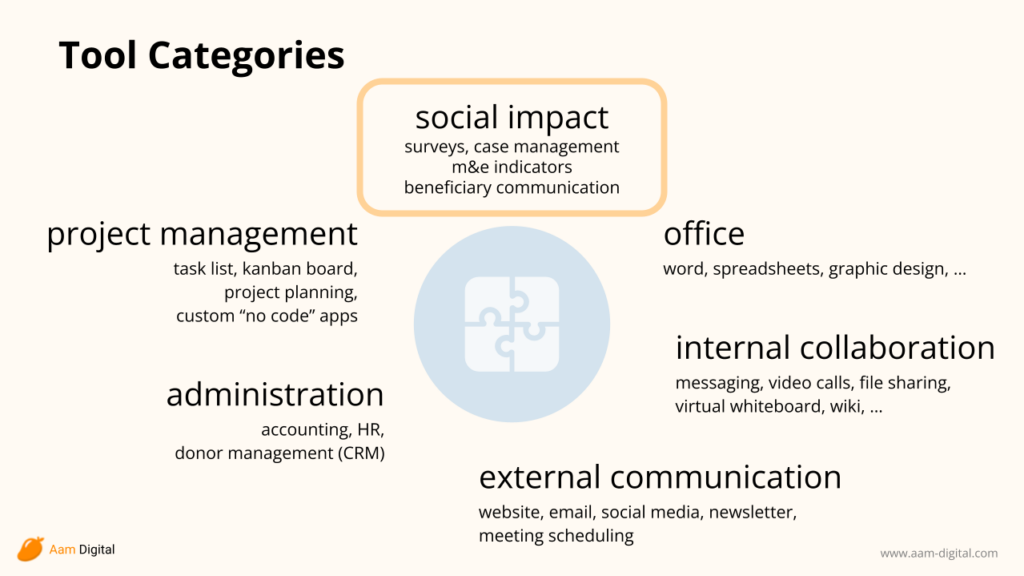“Digital transformation” is the talk of the hour but many NGOs with their special environment and constraints are still struggling to adopt digital tools for their work. Let’s try to give a broad overview to help get started here.
Digitization has become increasingly important in many industries, including healthcare, finance, and education, as it enables more efficient data management, better data analysis, and improved communication and collaboration. It also allows for easier access to information, as digital data can be easily searched, shared, and retrieved from anywhere with an internet connection.
[What the ChatGPT AI has to say about “digitization”]
The most important thing first: Technology should help you achieve your goals and solve your problems. Look at how digital tools (big or small) can contribute to your existing strategy, rather than starting with the technology in mind. Digital solutions can support almost any area of an organization. And there are different levels of depth you can go to with digital tools.
Levels of digitization
Introducing a digital tool does not always have to be a year-long change management process. In the software sector itself “agile” approaches have become the industry standard. That means, introducing new things gradually step by step – and learning from the first small changes about what works and what needs a different approach (which can give you insights about the technology as well as the process to bring your team on board). Adoption of digital tools can be split into different levels:
- Individual simple tools: There are a lot of small, often free tools available to help with isolated aspects (e.g. Doodle or Calendly to schedule meetings; a GoogleDoc to collaborate in real time, online on a report draft). Depending on your organization’s policies you can maybe just try these without a long decision process.
- Dedicated & integrated systems: A specialized system for some of your processes that everyone uses can often replace a lot of manual forth and back. For example, a CRM (Customer Relationship Management) or case management system where your whole team manages their tasks and communication with your donors or participants can give everyone access to important details without constantly forwarding emails or writing internal reports. But of course the process to introduce such a more complex system will take time and effort.
- Re-inventing programs digitally: You may decide not to go this far – and that is absolutely fine. Changing your project’s approach completely based on new technology is radical – an idea like “We’ll replace our in-person workshops with an AI-powered chatbot to reach 1000x more beneficiaries” does not always make sense. If you go in this direction, make sure you carefully pilot a concept before diving in completely.
Areas of digitization
There are tools for most internal and external areas of your work. For a lot of aspects social sector organizations do not need anything different from companies and there are lots of solutions in the market (often offering discounts for nonprofits).

Beyond the general software tools there are a few types of solutions for social impact projects specifically, catering to the use cases and environments of NGOs (e.g. tailored to reporting requirements of NGOs or allowing to work offline):
- Data collection (e.g. for offline, digital baseline surveys)
- For example: KoboToolbox
- Case management (e.g. to monitor all details and developments of beneficiaries and generate numbers for m&e reports)
- For example: Aam Digital (our own open-source platform), Primero and other systems often specialized to particular use cases
- M&E reporting: (e.g. to manage indicators and log frames for monitoring & evaluation)
- For example: TolaData
- … and many other fields
- For example: Glific, to automate communication with participants through WhatsApp chatbots
The products linked here are examples to showcase possible solutions and not an endorsement. One large listing of solutions vetted for quality standards is the Digital Public Goods registry.
Don’t be afraid to ask and experiment
Making use of digital solutions can take many forms. Take small steps, try things and focus on solutions towards pain points that are already holding your back.
And don’t be afraid to ask. There are a communities, foundations and service providers who will be happy to answer your questions, show you their solutions and help your find your path.
Further resources:
- Digital Public Goods registry
- Tech Soup offers special discounts on software to nonprofits

One Response